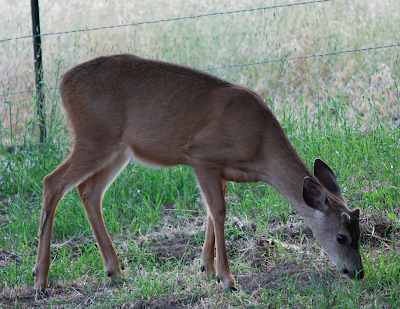This is the third in a series about summer deer families on the Dipper Ranch. Today's blog is about Bump and Button.
BUMP - this doe has a large mole-like bump on the inside of her left foreleg (see photo above). It is about 2" x 1" , dark grey, and has no antennae. She doesn't seem to scratch it or limp on that side, so I assume it is some type of harmless dermatological irregularity. Who knew deer had beauty spots? Bump has no cuts in her ears.
BUTTON - Bump is usually attended by a young buck, Button, who has 1" long antler buttons. Button has clean-margined ears and I assume he is a yearling. The 2009 Bump & Button pair may be the same doe-male fawn pair I saw frequently in the Fall of 2008. I hadn't trained myself to distinguish individual deer then, but I have observed similar feeding and bedding behavior between the years. Most young bucks disperse at about 16 months of age. I would expect Button to separate from Bump this fall during the breeding season.
 --- This summer, Button has an adult-sized body, but his antlers are short. ---
--- This summer, Button has an adult-sized body, but his antlers are short. ---
The Columbian black-tailed deer of central coastal California is a subspecies of mule deer which range across large areas of the western US and Canada. The various mule deer subspecies survive in different environments and have somewhat different physical features and behavior.
Only the males carry antlers in mule deer. The velvet-covered antler bulbs appear on the top of their head every spring and may grow as much as 1 centimeter per day in the summer. The antlers stop growing and the velvet dries and is rubbed off in late August and September as the bucks prepare for the annual rut. Antlers are used for sparring between bucks, with dominant bucks getting more access to does for mating. The antlers are shed in late January or early February.

Yearling male mule deer with adequate diets normally have 2 points on each side of their antlers and 2-year old bucks typically have 4-point antlers on each side. Thereafter, subsequent annual growth may be more in the diameter and length of the antler and not an increase in the number of points, thus the age of a deer cannot be determined by its antler points. Nutritional conditions of the buck largely influence the growth of its antlers.
Button's antlers seem small for his age and body size. The black-tailed subspecies living in the mild climate of coastal California is generally smaller and starts its annual cycle sooner than many of the other subspecies of mule deer. Button still has another 1 to 2 months of antler growth this summer to see if he gets any divided points.
I am not sure why Bump does not have a new fawn this year. Possibly, she is a young doe which do not conceive every year, or she lost a fawn earlier in the year before bringing it out of hiding. In mule deer populations, 25 to 30% of the fawns are lost by the fall months, and 75% do not make it to their first spring (Feldhamer, et al.). Again, the nutritional level is a primary influence on deer survival.

--- Button is waving his head, but showing his size compared to Bump. ---
See also:
- Wild Mammals of North America, George A. Feldhamer, Bruce C. Thompson, and Joseph A. Chapman, editors, John Hopkins University Press, 2003.

Hi Cindy - Tom the volunteer sent me this site, I thought you might enjoy.
ReplyDeleteHope you are well!
Miri
http://www.hicksroad.com/html/greatoaks.htm